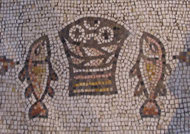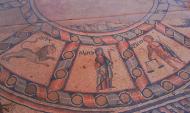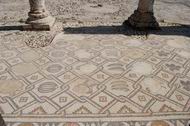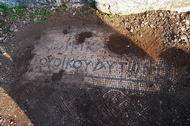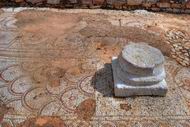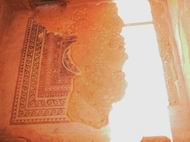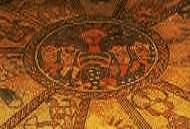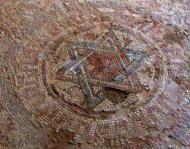An overview of ancient mosaic floors that are featured in Biblewalks.com

Home > Info > Mosaics overview
Contents:
* Background
* History
* Biblewalks sites of mosaics
* Mosaics museum
* Links
* Mosaics News
Background:
This web page provides an overview on Mosaic floors, listing pages that feature ancient mosaics in Biblewalks.com.
Mosaics were a common architecture element during the Hellenistic, Roman and Byzantine periods. Mosaics were used to decorate most of the the public, religious and residential buildings .
The mosaic floor, which was designed and laid out by special artists, is composed of thousands of colored stones which were laid out on a layer of cement. The mosaics depict Biblical scenes, Jewish and Christian symbols, inscriptions, nature scenes, Greek mythology stories and heroes, and other paintings.
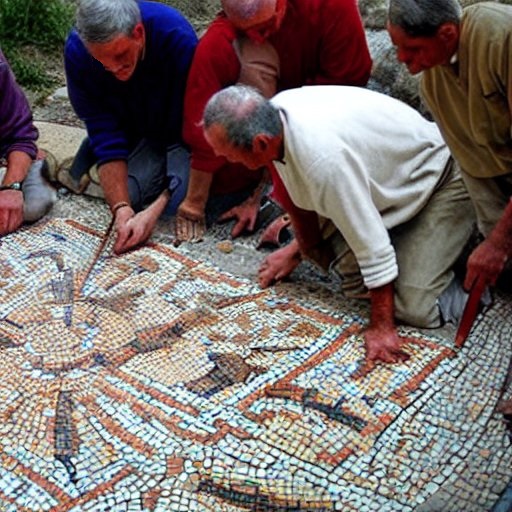
Artists working on a mosaic floor – AI generated by Stable Diffusion
History:
Mosaic floors have been used since ancient times, and their history can be traced back to various civilizations. The earliest known examples of mosaic floors date back to the 8th century BC in Mesopotamia and the Near East.
The ancient Greeks were known for their intricate and colorful mosaics, which were used to decorate floors, walls, and even furniture. The most famous examples of ancient Greek mosaics can be found in the ancient city of Pompeii, which was preserved by volcanic ash after the eruption of Mount Vesuvius in 79 AD.
The Romans were also known for their elaborate use of mosaics, which they used to decorate public buildings, villas, and even tombs. The most famous examples of Roman mosaics can be found in the ancient city of Tivoli, near Rome.
During the Middle Ages, mosaic floors continued to be used in churches and other religious buildings. The Byzantine Empire, which lasted from the 4th century to the 15th century, was known for its intricate mosaics, which were used to decorate churches and other public buildings.
In the Renaissance period, mosaic floors became popular once again, with artists such as Michelangelo and Raphael using them in their works.
Today, mosaic floors continue to be used in both traditional and contemporary settings, with modern techniques and materials allowing for even greater creativity and flexibility in their design and application.
Links to Biblewalks sites:
A sample of ancient mosaic floors are featured in the following pages:
- Airport Mosaics (displayed at Ben-Gurion airport)
- Sepphoris Mosaics (2nd to 7th century AD, a rich city with amazing mosaics)
- “Mona Lisa of the Galilee“ in Sepphoris – a 3rd century beauty
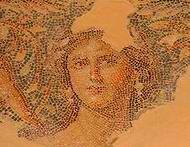
- Nahariyah (6th century AD Byzantine church)
- Shavey Zion (5/6th century Byzantine church)
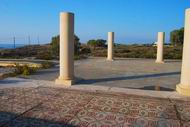
- Mosaics of the Basilica of Annunciation (19th century mosaics in Nazareth)
- Tabcha – 5th century AD mosaics, with first feeding miracle scene
- BethLehem in the Galilee (5-6th century AD)
- Hammat Tiberias 5th century Zodiac mosaic.
-
Dominus Flevit modern basilica above 5th-6th century Byzantine church ruins
- Kursi ruins of 6th century Church – miracle of healing madman through swine
- Russian Orthodox Convent of the Ascension – 6th century Byzantine mosaic
- Khirbet Heshek ruins of 5th century church, inscription dedicating to St. George
- Ein Gedi – 5th century Synagogue – the lowest mosaic in the world
- Hurvat Kav – ruins of Byzantine church
- Monastery of the Cross – Byzantine church, with blood stains
- Masada – Herodian palace
- Beit Alpha – 6th century Zodiac
- Mamshit – churches – 4th to 7th century
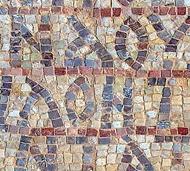
- Inn of Good Samaritan – museum of mosaics
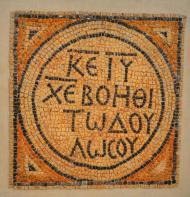
- Shiloh – Church of the 40 – Byzantine
“Good Samaritan” Mosaics Museum:
A unique museum has opened in 2009 in Ma’ale Adummim, on the side of the Jerusalem-Jericho road. The museum is located on the site of the ancient inn (Khan) of the Good Samaritan. It displays archaeological findings which were excavated in the West Bank and Gaza. The museum has both an outdoor and indoor sections, and the majority of the findings are sections of the mosaic floors collected from different sites.
Visit the site: Good Samaritan museum
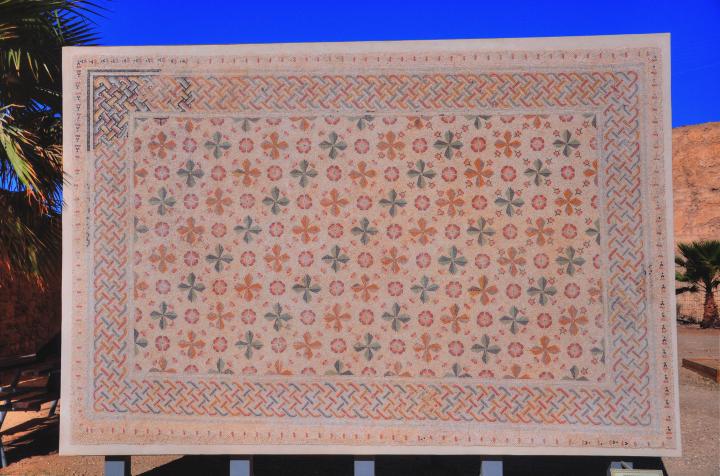
Links:
- Hecht Museum – article on ancient mosaics (abstract only)
- Mosaics of the Land of Israel – (Power point; Hebrew)
- Site conservation – see section on mosaics
- Ancient Mosaic stock photos
Mosaics floor News:
- Spectacular Mosaic floor restored and on display (March 2009)
- Mosaics Museum “The Good Samaritan” opens to the public – first in Israel (June 2009)
Check our review of the museum
- Most impressive/Largest mosaic floor to be re-exposed in Lod (Lydda) (June 2009)
BibleWalks.com – walk with us through the sites of the Holy Land
Mud Bricks<<<—Previous —<<< All Info >>>—Next Info—>>> Airport Mosaics
This page was last updated on Mar 24, 2023 (add history)
Sponsored links:
